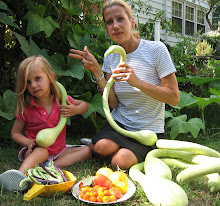
The weather has been unbelievably warm for more days than not over the past two weeks – I felt like planting tomatoes! As it is, my collards wintered over and one plant is producing enough leaves that I’ll probably harvest a bunch shortly to simmer with ham and potatoes.
Each year a leave a few things in the ground over the winter for the rabbits, whom I spy from time to time in the depths of night nibbling in the beds after a trek over our snow-covered yard. This year, I left the Swiss chard and some collards. The chard has been composted. The collards remain. And the rabbits have moved on to tender spring shoots and leaves elsewhere.
I am dying to start planting my garden beds anew. However, I needed to amend the soil. I turned to an old mine and struck gold: rich, organic matter that I call Black Gold. I top-dressed my beds this week with steaming black humus from the town.
Every year, my town makes available composted leaves to its residents. All you have to do is pick it up at the Department of Public Works. I wait for it all winter, and once it’s in come Spring, I hit the road to pick-up a trunk load or two of it. But this year, I’m shoveling humus into bags and bins like there’s no tomorrow. And it never ceases to disappoint.
The humus was actually steaming. It was very warm to the touch, alive in fact. I love this stuff! So do the plants. And not just the crops. For example, top dress around the trunks or bases of your evergreens, in a circle at least the width of the plant in spring and fall. It’s free, natural and healthy “food” for them.
The overhead shot of the long, oval beds shows two of the three for summer production. They are, for now, just top dressed with about six inches of the composted leaves. With the DPW yard’s limited hours, my main goal over the past week of 70-degree weather was simply to back into the dirt bay, fill the bins and bags in the trunk of my car, unload, spread, and head back for more before the yard closes at 3:00 p.m. and I need to pick up my daughter from school. The yard doesn’t have weekend hours until mid-May, and that’s just too late in the season for me. And anyway, it feels great to get down and dirty again!
I’d already applied a layer of dehydrated, composted manure; the humus is icing on the cake. In the coming weeks, wielding a pitchfork, I’ll turn all of the soil over and integrate the amendments
thoroughly. It’s an old-fashioned but tried and true way of doing things, but the aches and pains are well worth it: the soil will be aerated, crumbly, well amended and ready to accommodate and nourish tender seedling roots.
Two types of kale, cabbage seeds, lettuces and cippolini onion seed will be in the ground within two weeks – I can’t wait!
Each year a leave a few things in the ground over the winter for the rabbits, whom I spy from time to time in the depths of night nibbling in the beds after a trek over our snow-covered yard. This year, I left the Swiss chard and some collards. The chard has been composted. The collards remain. And the rabbits have moved on to tender spring shoots and leaves elsewhere.
I am dying to start planting my garden beds anew. However, I needed to amend the soil. I turned to an old mine and struck gold: rich, organic matter that I call Black Gold. I top-dressed my beds this week with steaming black humus from the town.
Every year, my town makes available composted leaves to its residents. All you have to do is pick it up at the Department of Public Works. I wait for it all winter, and once it’s in come Spring, I hit the road to pick-up a trunk load or two of it. But this year, I’m shoveling humus into bags and bins like there’s no tomorrow. And it never ceases to disappoint.
The humus was actually steaming. It was very warm to the touch, alive in fact. I love this stuff! So do the plants. And not just the crops. For example, top dress around the trunks or bases of your evergreens, in a circle at least the width of the plant in spring and fall. It’s free, natural and healthy “food” for them.
The overhead shot of the long, oval beds shows two of the three for summer production. They are, for now, just top dressed with about six inches of the composted leaves. With the DPW yard’s limited hours, my main goal over the past week of 70-degree weather was simply to back into the dirt bay, fill the bins and bags in the trunk of my car, unload, spread, and head back for more before the yard closes at 3:00 p.m. and I need to pick up my daughter from school. The yard doesn’t have weekend hours until mid-May, and that’s just too late in the season for me. And anyway, it feels great to get down and dirty again!
I’d already applied a layer of dehydrated, composted manure; the humus is icing on the cake. In the coming weeks, wielding a pitchfork, I’ll turn all of the soil over and integrate the amendments
thoroughly. It’s an old-fashioned but tried and true way of doing things, but the aches and pains are well worth it: the soil will be aerated, crumbly, well amended and ready to accommodate and nourish tender seedling roots.
Two types of kale, cabbage seeds, lettuces and cippolini onion seed will be in the ground within two weeks – I can’t wait!












